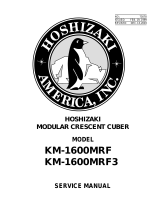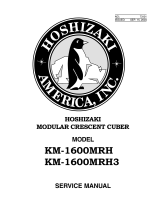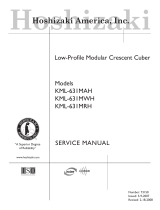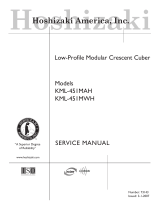
20
1. Operation Diagnosis
3) Power On: Turn on the power supply, then move the control switch to the "ICE" position.
A 5-sec. delay occurs. CB red "POWER OK" LED and green "BC CLOSED" LED turn
on. If yellow "BC OPEN" LED is on (indicating a full bin), check BC. Move ice away from
BC actuator paddle. If yellow "BC OPEN" LED stays on, see "II.D. Bin Control Check.".
Note: • CB red "POWER OK" LED remains on unless the 10.5VAC power supply is
interrupted (K2 connector).
• Check CB using the steps in "II.C.Control Board Check."
• Conrm CB green "BC CLOSED" LED is on. If CB yellow "BC OPEN" LED is on,
remove ice from BC. If no ice is around BC and yellow "BC OPEN" LED is on,
see "II.D.2. Bin Control Check."
a) Power On Diagnosis: If CB red "POWER OK" LED is off, conrm 10A fuse is good.
Check for 115VAC at control switch #1 (BR) to neutral (W) then at control switch
#2(P) to neutral (W). If 115VAC is present on #1 (BR) and not on #2(P), replace
control switch. If 115VAC is present on control switch #2 (P), check for 115VAC at
HPS (P) to neutral (W) then HPS (BK) to neutral (W). If115VAC is present at HPS
(P) and not at HPS (BK), HPS is open. See HPS Diagnosis below. If115VAC is
present at HPS (BK), check for 10.5VAC at CB K2#1 red wire to CB K2 #2 red wire.
If10.5VAC is not present, check that the cleaning valve interlock switch is closed.
Next, check CT continuity. If open, replace CT.
b) HPS Diagnosis: Conrm condenser coil is not clogged or restricted. Let refrigeration
circuit pressures equalize. If HPS does not reset and pressures are equalized,
replace HPS. Ifpressures are not equalized, reclaim refrigerant and diagnose
refrigeration circuit restriction. Check that there are no restrictions in the refrigeration
circuit.
Harvest Cycle: HGV, strainer, or check valve.
Freeze Cycle: FM, FMR, TXV, HM, LLV, WRV, strainer, check valve, drier, damaged
line set or tting, and fan blade for binding.
Conrm that the location meets installation requirements. See the appliance's
instruction manual for details.
4) 1-Min. Fill Cycle – LED 4 is on. WV and X11 relay energize. After 1 min., CB checks for
a closed FS. If FS is closed, the harvest cycle begins. If harvest cycle begins (Comp,
HGV, FMR energized), continue to step 5a. If FS is open, WV remains energized until
FS closes (low water safety protection during initial start up and at the end of each
harvest). Diagnosis: Check that water enters the water tank. If not, check that the water
supply line shut-off valve is open and screens or external lters are clear. Check for
115VAC at CB K1 #6 (O) to neutral (W). If 115VAC is not present, replace CB. If 115VAC
is present, and WV does not energize, check for 115VAC at WV. If 115VAC is present,
check coil continuity. Ifopen, replace WV. If the water tank lls, but the appliance fails to
start harvest (Comp energized), check for open FS. See "II.E. Float Switch Check and
Cleaning." If FS is closed and CB fails to start the harvest cycle after 1 min., replace CB.
























